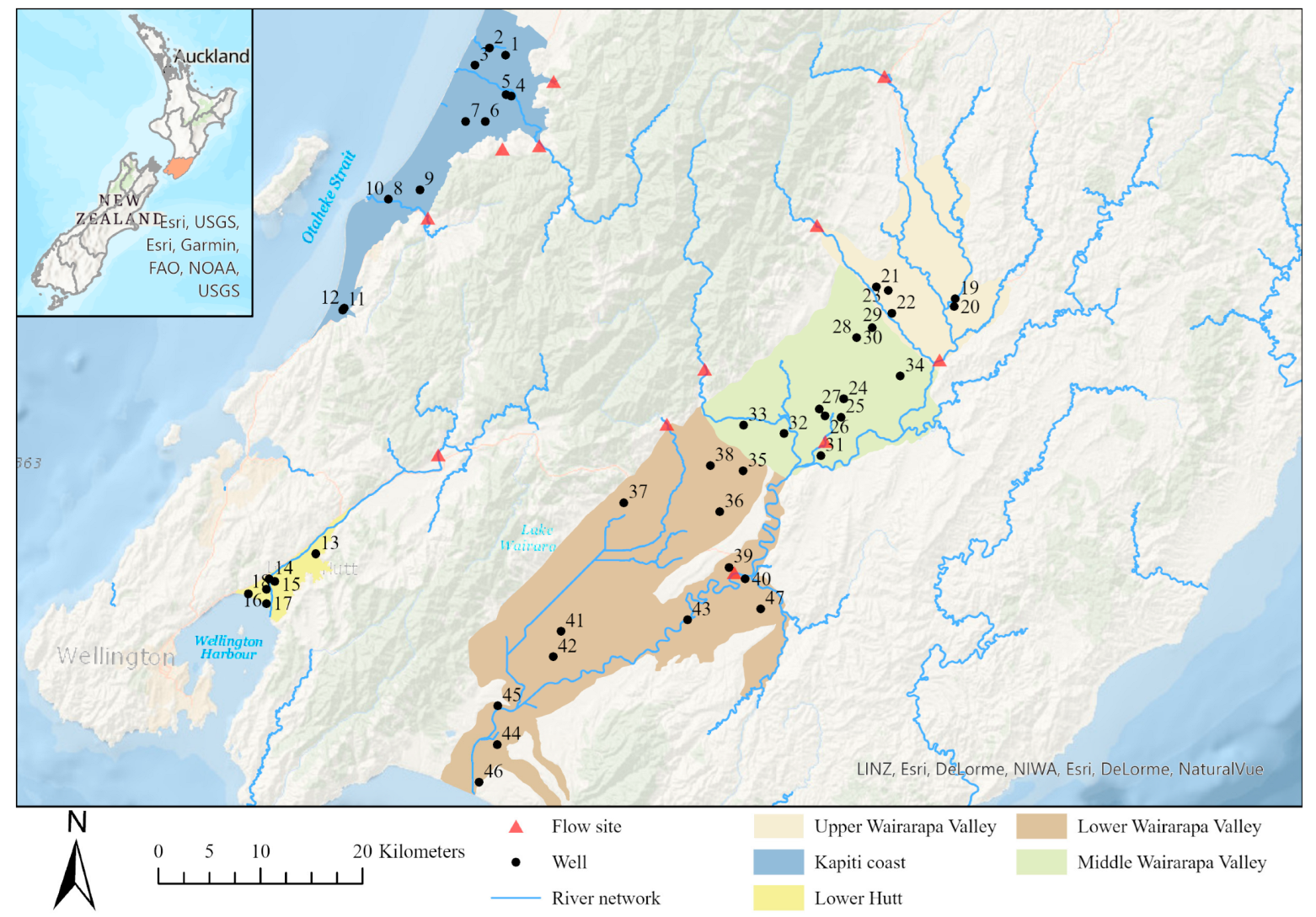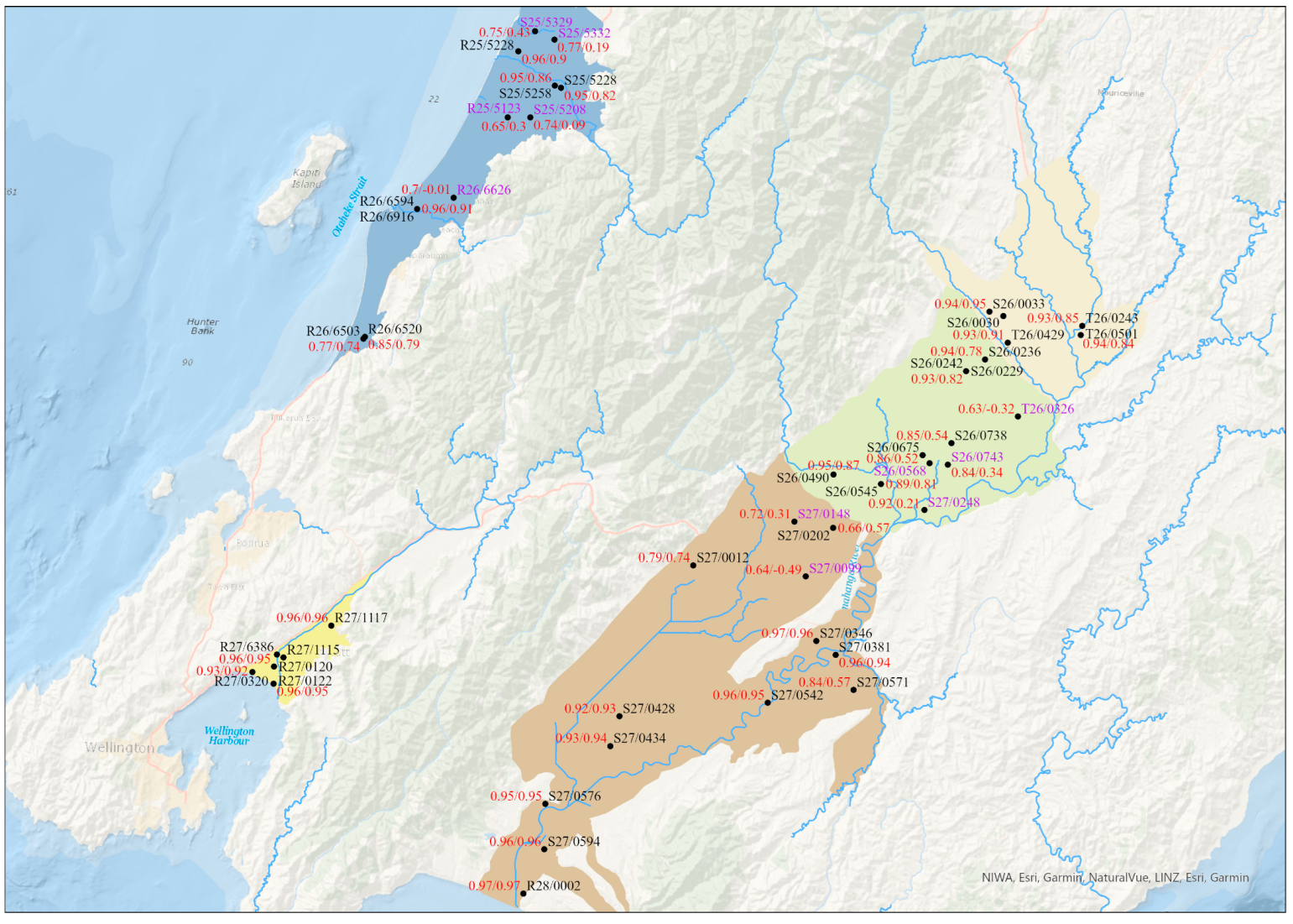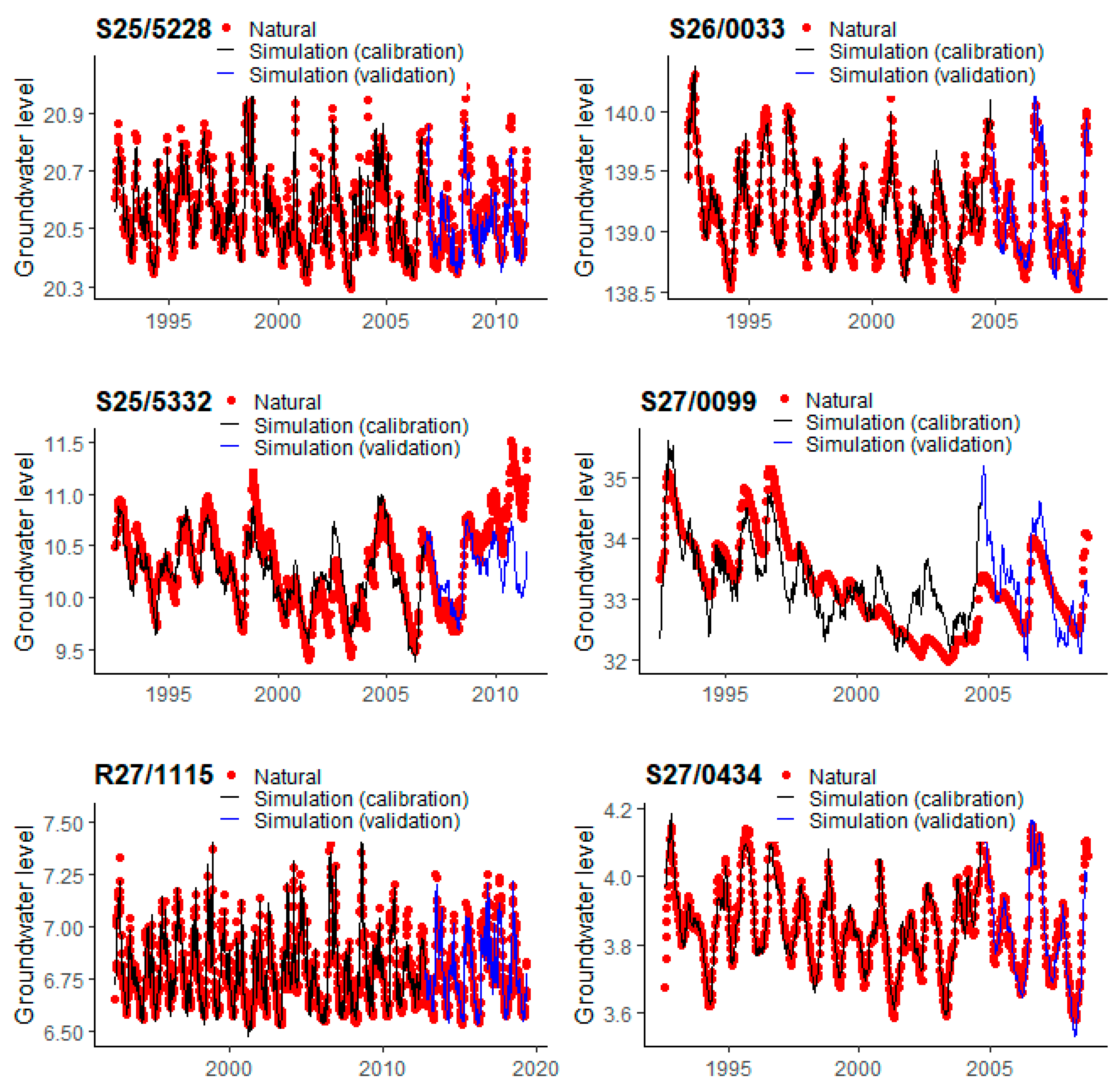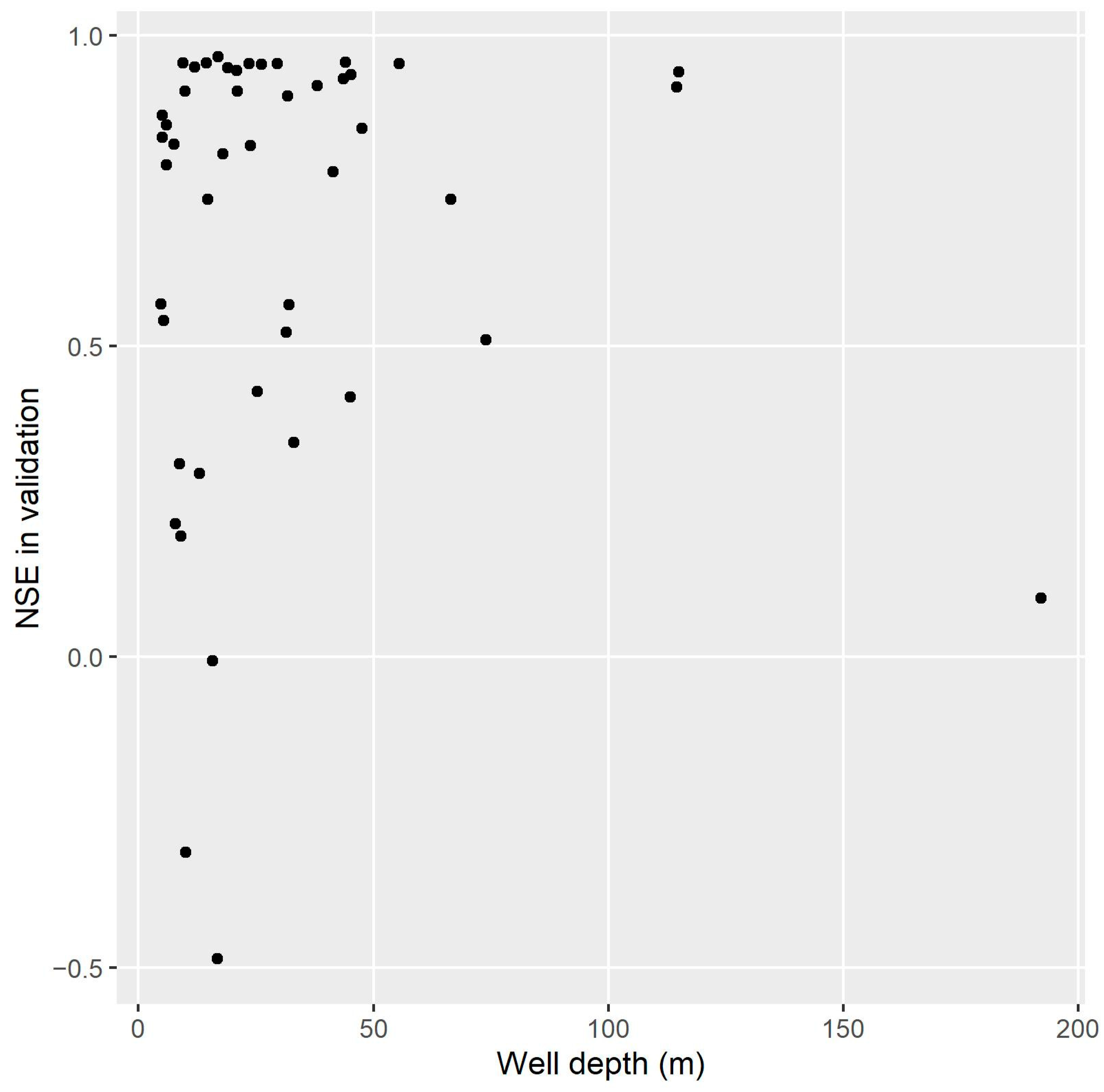Metamodelling of Naturalised Groundwater Levels at a Regional Level in New Zealand
Abstract
:1. Introduction
2. Materials and Methods
2.1. Methodology
2.1.1. Conceptual Model
2.1.2. Metamodel
2.2. Case Study and Data
2.2.1. Groundwater Systems in Greater Wellington Region
2.2.2. Naturalised Groundwater Levels
2.2.3. Weather Data and Flow Data
2.3. Application Procedure
2.3.1. Initial Assessment of the Groundwater Level Data
2.3.2. Compilation of Weather and Flow Data
2.3.3. Setup of Model Predictors
- -
- weekly P, T, and PET (referred to as P_1, T_1 and PET_1), lagged weekly P, T, and PET with lag times of 2, 4, 9, 13, 17, 21, 26, 30, 40 and 50 weeks (e.g., lagged P is referred to as P_2, P_4 and so on), shifted weekly P, T, and PET with 2, 4, 9, 13, 17, 21, 26, 30, 40 and 50 weeks (e.g., shifted weekly P is referred to as P_s2, P_s4, and so on). Other weather variables (e.g., humidity) were excluded from a preliminary selection based on correlation analysis to reduce the number of model predictors.
- -
- weekly ratio of P and PET (PoP) with lag times of 2, 4, 9, 13, 17, 21, 26, 30, 40 and 50 weeks (as PoP_2, PoP_4, and so on). PoP is also referred to “dryness” of the weather condition (for a short period) or of climate condition (over a long period).
- -
- weekly flow data (referred to as Flow_1), lagged weekly flow at 2, 4, 9, 13, 17, 21, 26, 30, 40 and 50 weeks (referred to as Flow_2 and so on), and shifted weekly flow at 2, 4, 9, 13, 17, 21, 26, 30, 40 and 50 weeks (referred to as Flow_s2 as above).
2.3.4. Model Calibration, Validation and Assessment
3. Results
3.1. Model Performance
3.2. Influential Factors
4. Discussion
4.1. Model Performance
4.2. Importance of Factors
5. Conclusions
Author Contributions
Funding
Institutional Review Board Statement
Informed Consent Statement
Data Availability Statement
Acknowledgments
Conflicts of Interest
References
- Vrba, J.; van der Gun, J. The World’s Groundwater Resources: Contribution to Chapter 4 of WWDR-2. 2004. Available online: https://www.ircwash.org/sites/default/files/212.0-04WO-18539.pdf (accessed on 29 August 2023).
- Velis, M.; Conti, K.I.; Biermann, F. Groundwater and human development: Synergies and trade-offs within the context of the sustainable development goals. Sustain. Sci. 2017, 12, 1007–1017. [Google Scholar] [CrossRef]
- Siebert, S.; Burke, J.; Faures, J.M.; Frenken, K.; Hoogeveen, J.; Döll, P.; Portmann, F.T. Groundwater use for irrigation–A global inventory. Hydrol. Earth Syst. Sci. 2010, 14, 1863–1880. [Google Scholar] [CrossRef]
- Kløve, B.; Ala-Aho, P.; Bertrand, G.; Boukalova, Z.; Ertürk, A.; Goldscheider, N.; Ilmonen, J.; Karakaya, N.; Kupfersberger, H.; Kvœrner, J.; et al. Groundwater dependent ecosystems. Part I: Hydroecological status and trends. Environ. Sci. Policy 2011, 14, 770–781. [Google Scholar] [CrossRef]
- Wada, Y.; Van Beek, L.P.; Van Kempen, C.M.; Reckman, J.W.; Vasak, S.; Bierkens, M.F. Global depletion of groundwater resources. Geophys. Res. Lett. 2010, 37, L20402. [Google Scholar] [CrossRef]
- Mays, L.W. Groundwater resources sustainability: Past, present, and future. Water Resour. Manag. 2013, 27, 4409–4424. [Google Scholar] [CrossRef]
- Meyer, P.D.; Gee, G.W.; Nicholson, T.J. Information on Hydrologic Conceptual Models, Parameters, Uncertainty Analysis, and Data Sources for Dose Assessments at Decommissioning Sites (No. NUREG/CR-6656; PNNL-13091); Pacific Northwest National Lab. (PNNL): Richland, WA, USA, 2000.
- Enemark, T.; Peeters, L.J.; Mallants, D.; Batelaan, O. Hydrogeological conceptual model building and testing: A review. J. Hydrol. 2019, 569, 310–329. [Google Scholar] [CrossRef]
- Ferdowsian, R.; Pannell, D.J.; McCarron, C.; Ryder, A.; Crossing, L. Explaining groundwater hydrographs: Separating atypical rainfall events from time trends. Soil Res. 2001, 39, 861–876. [Google Scholar] [CrossRef]
- Yan, S.F.; Yu, S.E.; Wu, Y.B.; Pan, D.F.; Dong, J.G. Understanding groundwater table using a statistical model. Water Sci. Eng. 2018, 11, 1–7. [Google Scholar] [CrossRef]
- Harbaugh, A.W. MODFLOW-2005: The U.S. Geological Survey Modular Ground-Water Model—The Ground-Water Flow Process, U.S. Geological Survey Techniques and Methods 6-A16; US Department of the Interior, US Geological Survey: Reston, VA, USA, 2005.
- Diersch, H.J.G. FEFLOW—Finite Element Modelling of Flow, Mass and Heat Transport in Porous and Fractured Media; Springer: Berlin/Heidelberg, Germany, 2014. [Google Scholar] [CrossRef]
- Brunner, P.; Simmons, C.T. HydroGeoSphere: A fully integrated, physically based hydrological model. Ground Water 2012, 50, 170–176. [Google Scholar] [CrossRef]
- Keenan, L.; Thompson, M.; Mzila, D. Freshwater Allocation and Availability in the Wellington Region: State and Trends; Publication No. GW/EMI-T-12/141; Greater Wellington Regional Council: Wellington, New Zealand, 2012.
- Mzila, D. Groundwater Level Trend Analysis for the Wellington Region: Internal Technical Paper Prepared in Support of State of Environment Reporting; Greater Wellington Region Council: Wellington, New Zealand, 2012.
- Gyopari, M. Lower Hutt Aquifer Model Revision (HAM3): Sustainable Management of the Waiwhetu Aquifer; Greater Wellington Regional Council: Wellington, New Zealand, 2014.
- Gyopari, M.; McAlister, D. Wairarapa Valley Groundwater Resource Investigation: Upper Valley Catchment Hydrogeology and Modelling; Technical Publication No. GW/EMI-T-10/74; Greater Wellington Regional Council: Wellington, New Zealand, 2010.
- Gyopari, M.; McAlister, D. Wairarapa Valley Groundwater Resource Investigation: Middle Valley Catchment Hydrogeology and Modelling; Technical Publication No. GW/EMI-T-10/73; Greater Wellington Regional Council: Wellington, New Zealand, 2010.
- Gyopari, M.; McAlister, D. Wairarapa Valley Groundwater Resource Investigation: Lower Valley Catchment Hydrogeology and Modelling; Technical Publication No. GW/EMI-T-10/75; Greater Wellington Regional Council: Wellington, New Zealand, 2010.
- Gyopari, M.; Mzila, D.; Hughes, B. Kapiti Coast Groundwater Resource Investigation: Catchment Hydrogeology and Modelling Report; Publication No. GW/ESCI-T-14/92; Greater Wellington Regional Council: Wellington, New Zealand, 2014.
- Christelis, V.; Hughes, A.G. Metamodel-assisted analysis of an integrated model composition: An example using linked surface water–groundwater models. Environ. Model. Softw. 2018, 107, 298–306. [Google Scholar] [CrossRef]
- Fienen, M.N.; Nolan, B.T.; Feinstein, D.T. Evaluating the sources of water to wells: Three techniques for metamodeling of a groundwater flow model. Environ. Model. Softw. 2016, 77, 95–107. [Google Scholar] [CrossRef]
- Asher, M.J.; Croke, B.F.; Jakeman, A.J.; Peeters, L.J. A review of surrogate models and their application to groundwater modeling. Water Resour. Res. 2015, 51, 5957–5973. [Google Scholar] [CrossRef]
- Di Salvo, C. Improving Results of Existing Groundwater Numerical Models Using Machine Learning Techniques: A Review. Water 2022, 14, 2307. [Google Scholar] [CrossRef]
- Kumar, V.; Holzkaemper, A.; Lerner, D.N. Integrated meta-modelling for decision support in integrated catchment management. In Proceedings of the 5th International Congress on Environmental Modelling and Software, Ottawa, ON, Canada, 5–8 July 2010; Available online: https://scholarsarchive.byu.edu/iemssconference/2010/all/218/ (accessed on 4 September 2023).
- Yan, Y.; Feng, C.C.; Wan, M.P.H.; Chang, K.T.T. Multiple Regression and Artificial Neural Network for the Prediction of Crop Pest Risks. In Information Systems for Crisis Response and Management in Mediterranean Countries; ISCRAM-med 2015, Lecture Notes in Business Information Processing; Bellamine, B.S.N., Adam, C., Hanachi, C., Eds.; Springer: Cham, Switzerland, 2015; Volume 233. [Google Scholar]
- Tsakiri, K.; Marsellos, A.; Kapetanakis, S. Artificial neural network and multiple linear regression for flood prediction in Mohawk River, New York. Water 2018, 10, 1158. [Google Scholar] [CrossRef]
- Osman, A.I.A.; Ahmed, A.N.; Huang, Y.F.; Kumar, P.; Birima, A.H.; Sherif, M.; Sefelnasr, A.; Ebraheemand, A.A.; El-Shafie, A. Past, Present and Perspective Methodology for Groundwater Modeling-Based Machine Learning Approaches. Arch. Comput. Methods Eng. 2022, 29, 3843–3859. [Google Scholar] [CrossRef]
- Afrifa, S.; Zhang, T.; Appiahene, P.; Varadarajan, V. Mathematical and Machine Learning Models for Groundwater Level Changes: A Systematic Review and Bibliographic Analysis. Future Internet 2022, 14, 259. [Google Scholar] [CrossRef]
- Payne, K.; Chami, P.; Odle, I.; Yawson, D.O.; Paul, J.; Maharaj-Jagdip, A.; Cashman, A. Machine Learning for Surrogate Groundwater Modelling of a Small Carbonate Island. Hydrology 2023, 10, 2. [Google Scholar] [CrossRef]
- Razavi, S.; Tolson, B.A.; Burn, D.H. Review of surrogate modeling in water resources. Water Resour. Res. 2012, 48, W07401. [Google Scholar] [CrossRef]
- Xu, T.; Liang, F. Machine learning for hydrologic sciences: An introductory overview. Wiley Interdiscip. Rev. Water 2021, 8, e1533. [Google Scholar] [CrossRef]
- Beven, K. TOPMODEL: A critique. Hydrol. Process. 1997, 11, 1069–1085. [Google Scholar] [CrossRef]
- Aho, K.; Derryberry, D.; Peterson, T. Model selection for ecologists: The worldviews of AIC and BIC. Ecology 2014, 95, 631–636. [Google Scholar] [CrossRef]
- Tait, A.; Henderson, R.; Turner, R.; Zheng, X.G. Thin plate smoothing spline interpolation of daily rainfall for New Zealand using a climatological rainfall surface. Int. J. Climatol. 2006, 26, 2097–2115. [Google Scholar] [CrossRef]
- Gupta, H.V.; Kling, H.; Yilmaz, K.K.; Martinez, G.F. Decomposition of the mean squared error and NSE performance criteria: Implications for improving hydrological modelling. J. Hydrol. 2009, 377, 80–91. [Google Scholar] [CrossRef]
- Knoben, W.J.; Freer, J.E.; Woods, R.A. Inherent benchmark or not? Comparing Nash–Sutcliffe and Kling–Gupta efficiency scores. Hydrol. Earth Syst. Sci. 2019, 23, 4323–4331. [Google Scholar] [CrossRef]
- Moriasi, D.N.; Gitau, M.W.; Pai, N.; Daggupati, P. Hydrologic and water quality models: Performance measures and evaluation criteria. Trans. ASABE 2015, 58, 1763–1785. [Google Scholar]






| No | Site ID | Well Depth (m) 1 | Risk Category 2 | Aquifer | Flow Site |
|---|---|---|---|---|---|
| 1 | S25/5332 | 9.1 | Low | Kapiti coast | |
| 2 | S25/5329 | 25.3 | Low | Kapiti coast | |
| 3 | R25/5228 | 31.7 | Low | Kapiti coast | A: Otaki at Pukehinau |
| 4 | S25/5228 | Unknown | Low | Kapiti coast | A: Otaki at Pukehinau |
| 5 | S25/5258 | 6.0 | Low | Kapiti coast | A: Otaki at Pukehinau |
| 6 | S25/5208 | 192.0 | High | Kapiti coast | |
| 7 | R25/5123 | 13.0 | Low | Kapiti coast | |
| 8 | R26/6594 | 74.0 | Low | Kapiti coast | B: Waikanae at WTP |
| 9 | R26/6626 | 15.8 | High | Kapiti coast | |
| 10 | R26/6916 | 21.0 | Low | Kapiti coast | B: Waikanae at WTP |
| 11 | R26/6503 | 14.8 | Low | Kapiti coast | |
| 12 | R26/6520 | 6.0 | Low | Kapiti coast | |
| 13 | R27/1117 | 14.4 | NA | Lower Hutt | C: Hutt at Birchville |
| 14 | R27/6386 | 115 | NA | Lower Hutt | C: Hutt at Birchville |
| 15 | R27/1115 | 23.47 | NA | Lower Hutt | C: Hutt at Birchville |
| 16 | R27/0120 | 29.6 | Low | Lower Hutt | C: Hutt at Birchville |
| 17 | R27/0122 | 26.2 | Low | Lower Hutt | C: Hutt at Birchville |
| 18 | R27/0320 | 114.6 | Low | Lower Hutt | C: Hutt at Birchville |
| 19 | T26/0243 | 47.5 | High | Upper Wairarapa Valley | D: Ruamahanga Mt Bruce |
| 20 | T26/0501 | 5.1 | Moderate | Upper Wairarapa Valley | D: Ruamahanga Mt Bruce |
| 21 | S26/0033 | 12.0 | Low | Upper Wairarapa Valley | E: Waingawa at Kaituna |
| 22 | T26/0429 | 9.9 | Low | Upper Wairarapa Valley | E: Waingawa at Kaituna |
| 23 | S26/0030 | 38.0 | High | Upper Wairarapa Valley | E: Waingawa at Kaituna |
| 24 | S26/0738 | 5.4 | Moderate | Middle Wairarapa Valley | |
| 25 | S26/0743 | 33.0 | Very high | Middle Wairarapa Valley | |
| 26 | S26/0568 | 45.0 | Low | Middle Wairarapa Valley | |
| 27 | S26/0675 | 31.5 | High | Middle Wairarapa Valley | |
| 28 | S26/0229 | 23.8 | Low | Middle Wairarapa Valley | E:Waingawa at Kaituna |
| 29 | S26/0236 | 41.4 | High | Middle Wairarapa Valley | E: Waingawa at Kaituna |
| 30 | S26/0242 | 7.5 | Low | Middle Wairarapa Valley | E:Waingawa at Kaituna |
| 31 | S27/0248 | 7.9 | Low | Middle Wairarapa Valley | |
| 32 | S26/0545 | 18.0 | High | Middle Wairarapa Valley | F: Waiohine Gorge |
| 33 | S26/0490 | 5.0 | Moderate | Middle Wairarapa Valley | F: Waiohine Gorge |
| 34 | T26/0326 | 10.0 | Low | Middle Wairarapa Valley | |
| 35 | S27/0202 | 4.8 | High | Lower Wairarapa Valley | |
| 36 | S27/0099 | 16.8 | Low | Lower Wairarapa Valley | |
| 37 | S27/0012 | 66.5 | Very high | Lower Wairarapa Valley | |
| 38 | S27/0148 | 8.8 | Low | Lower Wairarapa Valley | |
| 39 | S27/0346 | 9.5 | Low | Lower Wairarapa Valley | G: Ruamahanga Waihenga |
| 40 | S27/0381 | 20.9 | Low | Lower Wairarapa Valley | G: Ruamahanga Waihenga |
| 41 | S27/0428 | 43.6 | Very high | Lower Wairarapa Valley | G: Ruamahanga Waihenga |
| 42 | S27/0434 | 45.2 | Very high | Lower Wairarapa Valley | G: Ruamahanga Waihenga |
| 43 | S27/0542 | 19.0 | Moderate | Lower Wairarapa Valley | G: Ruamahanga Waihenga |
| 44 | S27/0594 | 44.0 | Low | Lower Wairarapa Valley | G: Ruamahanga Waihenga |
| 45 | S27/0576 | 55.5 | Moderate | Lower Wairarapa Valley | G: Ruamahanga Waihenga |
| 46 | R28/0002 | 17.0 | NA | Lower Wairarapa Valley | G: Ruamahanga Waihenga |
| 47 | S27/0571 | 32.0 | Low | Lower Wairarapa Valley | G: Ruamahanga Waihenga |
| Performance Metric | Very Good | Good | Satisfactory | Not Satisfactory |
|---|---|---|---|---|
| R2 | R2 > 0.85 | 0.75 < R2 ≤ 0.85 | 0.60 < R2 ≤ 0.75 | R2 ≤ 0.60 |
| NSE | NSE > 0.80 | 0.70 < NSE ≤ 0.80 | 0.50 < NSE ≤ 0.70 | NSE ≤ 0.50 |
Disclaimer/Publisher’s Note: The statements, opinions and data contained in all publications are solely those of the individual author(s) and contributor(s) and not of MDPI and/or the editor(s). MDPI and/or the editor(s) disclaim responsibility for any injury to people or property resulting from any ideas, methods, instructions or products referred to in the content. |
© 2023 by the authors. Licensee MDPI, Basel, Switzerland. This article is an open access article distributed under the terms and conditions of the Creative Commons Attribution (CC BY) license (https://creativecommons.org/licenses/by/4.0/).
Share and Cite
Yang, J.; Rajanayaka, C.; Daughney, C.J.; Booker, D.; Morris, R.; Thompson, M. Metamodelling of Naturalised Groundwater Levels at a Regional Level in New Zealand. Sustainability 2023, 15, 13393. https://doi.org/10.3390/su151813393
Yang J, Rajanayaka C, Daughney CJ, Booker D, Morris R, Thompson M. Metamodelling of Naturalised Groundwater Levels at a Regional Level in New Zealand. Sustainability. 2023; 15(18):13393. https://doi.org/10.3390/su151813393
Chicago/Turabian StyleYang, Jing, Channa Rajanayaka, Christopher J. Daughney, Doug Booker, Rebecca Morris, and Mike Thompson. 2023. "Metamodelling of Naturalised Groundwater Levels at a Regional Level in New Zealand" Sustainability 15, no. 18: 13393. https://doi.org/10.3390/su151813393
APA StyleYang, J., Rajanayaka, C., Daughney, C. J., Booker, D., Morris, R., & Thompson, M. (2023). Metamodelling of Naturalised Groundwater Levels at a Regional Level in New Zealand. Sustainability, 15(18), 13393. https://doi.org/10.3390/su151813393









